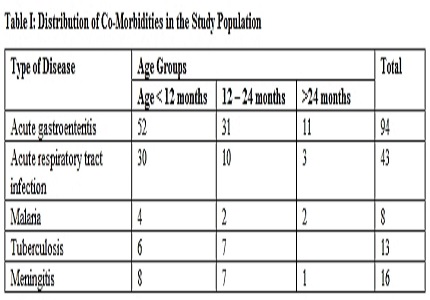Common co-morbidities and prescribing pattern of antibiotics in hospitalized SAM in Central India
Abstract
Objective: To study the co morbidities and prescribing pattern of antibiotics in hospitalized severe acute malnourishment (SAM) children.
Methods: 202 SAM children were included by simple random sampling technique
Results: 46.5% SAM children had diarrhea and 21.3% of children had acute respiratory tract infections (ARTI). Ceftriaxone/cefotaxime with aminoglycosides were administered to 52.9% children whereas ampicillin and gentamicin combination were given to only 18.8% children.
Conclusions: Diarrhea and ARTI are the common co-morbidities in hospitalized SAM children. Ceftriaxone/cefotaxime and aminoglycosides are the most commonly prescribed antibiotic combination. Despite epidemiological studies, more clinical and pharmacokinetic studies are needed for commonly prescribed antibiotics.
Downloads
References
2. Bhutta ZA, Ahmed T, Black RE et al., Maternal and Child Undernutrition Study Group. What works? Interventions for maternal and child undernutrition and survival Lancet. 2008 Feb 2;371(9610):417-40. doi: 10.1016/S0140-6736(07)61693-6.
3. World Health Organization. Management of Severe Malnutrition: A Manual for Physicians and Other Senior Health Workers, World Health Organization, Geneva, Switzerland, 1998. [PubMed]
4. de Onís M, Monteiro C, Akré J, Glugston G. The worldwide magnitude of protein-energy malnutrition: an overview from the WHO Global Database on Child Growth. Bull World Health Organ. 1993;71(6):703-12. [PubMed]
5. Bernal C1, Velásquez C, Alcaraz G, Botero J. Treatment of severe malnutrition in children: experience in implementing the World Health Organization guidelines in Turbo, Colombia. J Pediatr Gastroenterol Nutr. 2008 Mar;46(3):322-8. doi: 10.1097/MPG.0b013e318156c2c3. [PubMed]
6. Talbert A, Thuo N, Karisa J, Chesaro C, Ohuma E, Ignas J, et al. Diarrhoea complicating severe acute malnutrition in Kenyan children: A prospective descriptive study of risk factors and outcome. PLoS One. 2012; 7:1. doi: 10.1371/journal.pone.0038321.
7. Irena AH, Mwambazi M, Mulenga V. Diarrhea is a major killer of children with severe acute malnutrition admitted to inpatient set-up in Lusaka, Zambia. Nutr J. 2011 Oct 11;10:110. doi: 10.1186/1475-2891-10-110. [PubMed]
8. Berkowitz FE. Infections in children with severe protein-energy malnutrition. Pediatr Infect Dis J. 1992 Sep;11(9):750-9. [PubMed]
9. Hossain MI, Dodd NS, Ahmed T, Miah GM, Jamil KM, Nahar B, Alam B, Mahmood CB. Experience in managing severe malnutrition in a government tertiary treatment facility in Bangladesh. J Health Popul Nutr. 2009 Feb;27(1):72-9.
10. Bernal C, Velásquez C, Alcaraz G, Botero J. Treatment of severe malnutrition in children: experience in implementing the World Health Organization guidelines in Turbo, Colombia. J Pediatr Gastroenterol Nutr. 2008 Mar;46(3):322-8. doi:10.1097/MPG.0b013e318156c2c3.
11. Falbo AR, Alves JG, Batista Filho M, de Fátima Costa Caminha M, Cabral-Filho JE. Decline in hospital mortality rate after the use of the World Health Organization protocol for management of severe malnutrition. Trop Doct. 2009 Apr;39(2):71-2. doi: 10.1258/td.2008.080035.
12. WHO. Guideline: Updates on the management of severe acute malnutrition in infants and children. Geneva: World Health Organization; 2013. [PubMed]
13. Lazzerini M, Tickell D. Antibiotics in severely malnourished children: systematic review of efficacy, safety and pharmacokinetics. Bull World Health Organ. 2011 Aug 1;89(8):594-607. doi: 10.2471/BLT.10.084715. Epub 2011 May 20.

Copyright (c) 2016 Author (s). Published by Siddharth Health Research and Social Welfare Society

This work is licensed under a Creative Commons Attribution 4.0 International License.


 OAI - Open Archives Initiative
OAI - Open Archives Initiative


